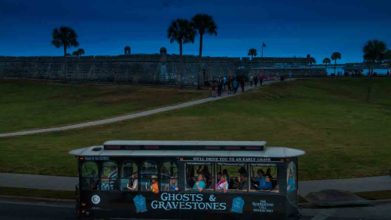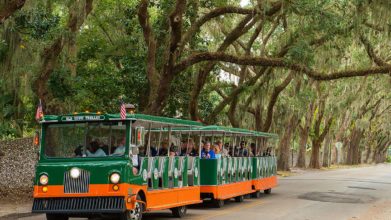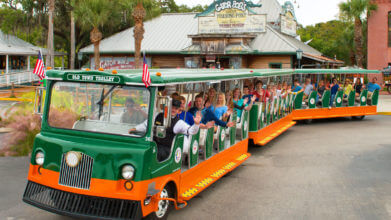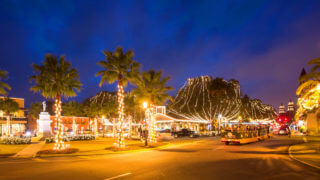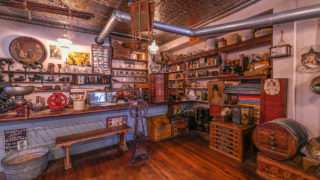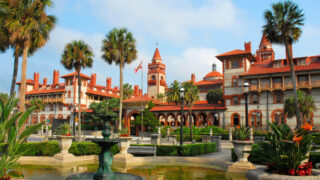Historic Churches of St. Augustine
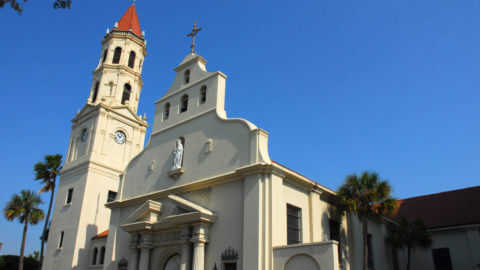
Houses of worship have played a significant role in St. Augustine’s history. Established by various denominations, these sanctuaries proclaim the faith of settlers who came to Florida in the hope of a better life.
The churches in St. Augustine afford a glimpse into the city’s diverse religious heritage.
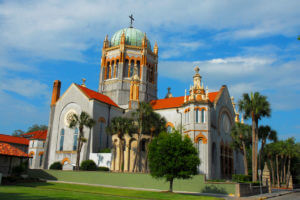 Memorial Presbyterian Church
Memorial Presbyterian Church
Henry Flagler built the beautiful Flagler Memorial Presbyterian Church in 1889 to honor the life of his late daughter Jenny. The Venetian Renaissance-style St. Augustine church features exquisite architectural details, including intricate terracotta friezes by Italian artists, hand-carved Santo Domino mahogany and a massive copper dome. Flagler as well as his daughter, granddaughter and first wife are buried in the adjacent mausoleum. Tours of this historic site at 32 Sevilla Street enable visitors to view the industrialist’s touching tribute to his daughter.
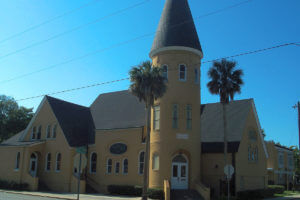 Ancient City Baptist Church
Ancient City Baptist Church
Eighteen charter members organized the Ancient City Baptist Church on January 20, 1887. Featuring a Norman tower and oval-shaped stained glass windows, the tan brick Romanesque Revival-style sanctuary was dedicated nine years later on a parcel of land at 27 Sevilla Street. Donated by Henry Flagler, the land grant contained stipulations that the congregation erect a debt-free house of worship costing no less than $10,000 that would never have a bell in the tower. The congregation met the debt-free challenge when they constructed the building sans a bell at a final cost of just over $14,345.
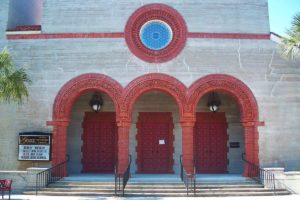 Grace United Methodist Church
Grace United Methodist Church
In 1887, Henry Flagler hired the same artisans who constructed his Ponce De Leon Hotel to erect the Grace United Methodist Church. The Spanish Renaissance Revival-style sanctuary with its terracotta spire and moldings is an enduring reminder of the influence that Spain has had on the city. The building was a replacement for the wood-frame Olivet Methodist Church that occupied another plot of land that Flagler wanted for his opulent Alcazar Hotel. Located at 8 Carrera Street, the church was listed on the National Register of Historic Places in 1979.
Cathedral Basilica of St. Augustine
The Cathedral Basilica of St. Augustine is the oldest Catholic house of worship in the city. Founded in 1565, the parish was the focal point of the Catholic community through the city’s early exploration, pirate domination and development by Henry Flagler. Featuring Spanish Mission and Neoclassical architectural styles, the current building was completed in 1797. Inspired by its Spanish colonial roots, the interior walls of the church are adorned with murals depicting the history of Catholicism in the New World. The stained glass windows illustrate the life of St. Augustine of Hippo for whom the church is named. The basilica, located at 38 Cathedral Place, was added to the National Register of Historic Places in 1970.
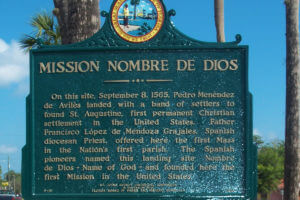 Mission of Nombre de Dios
Mission of Nombre de Dios
The roots of the Mission of Nombre de Dios trace to the establishment of the city in 1565. When Pedro Menendez de Aviles landed in St. Augustine on September 8 that year, he claimed the land for Spain and the church. It was on this site that the expedition’s chaplain Francisco Lopez celebrated the first parish mass. The serene setting at 27 Ocean Avenue includes a statue of Lopez, the Prince of Peace Church and an archaeological site as well as the Rustic Altar, the Our Lady of Guadalupe Shrine and the Great Cross. Rising 208 feet, the stainless steel cross, erected in 1965, commemorates the 400th anniversary of the first church service.
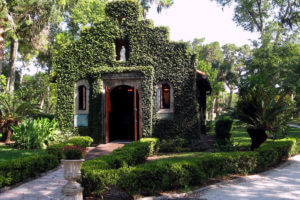 Shrine of Our Lady of La Leche
Shrine of Our Lady of La Leche
Located at 27 Ocean Avenue, the Shrine of Our Lady of La Leche is the first in the United States to be dedicated to Mary, the mother of Jesus. Established in 1615, the chapel houses an elegantly detailed carved statue of the Blessed Virgin nursing the child. Many pilgrims travel here to pray for blessings on behalf of mothers and mothers-to-be.
St. Photios Greek Shrine
Located on historic St. George Street, the shrine is dedicated to America’s first Greek enclave, which arrived in America in 1768. The distinctive shrine is adorned with beautiful Byzantine-style murals featuring 22-karat gold leaf that depict various apostles and saints in the Christian church. Exhibits, artifacts and historic memorabilia chronicle the lives of these early Greek settlers.
St. Cyprian Church
Established in 1893, St. Cyprian Episcopal Church was originally a safe place of worship for African-Americans during the post-Civil War, pre-Civil Rights era. Constructed in 1900 at what is now 37 Lovett Street in the Lincolnville neighborhood, the Carpenter Gothic-style church honors St. Cyprian, a North American saint whose work was similar to that of St. Augustine. The lot and construction costs were paid for by Emma White, a wealthy member of the white sister church, Trinity Parish. She was called to act after realizing the congregation was worshiping in members’ homes.
St. Benedict the Moor Church
Honoring the patron saint of African-Americans, St. Benedict the Moor Catholic Church was dedicated in 1911. This St. Augustine church has played a central role in the city’s African-American history. Three white Sisters of the Blessed Sacrament who taught at the parish school were arrested in 1916 for educating black children. Martin Luther King, Jr. used the rectory as a place to plan Civil Rights demonstrations in the area. The redbrick Spanish Mission-style edifice is located at 86 M L King Avenue.
Trinity Episcopal Church
Established in 1821, Trinity Episcopal Church at 215 St. George Street is the oldest Protestant congregation in Florida. Originally constructed from coquina in 1830, the sanctuary was renovated and enlarged in the early 1900s. The cruciform neo-Gothic church features stained glass windows, including the triptych above the altar which were made by Louis Tiffany, Henry Payne and the Franz Mayer Company.

